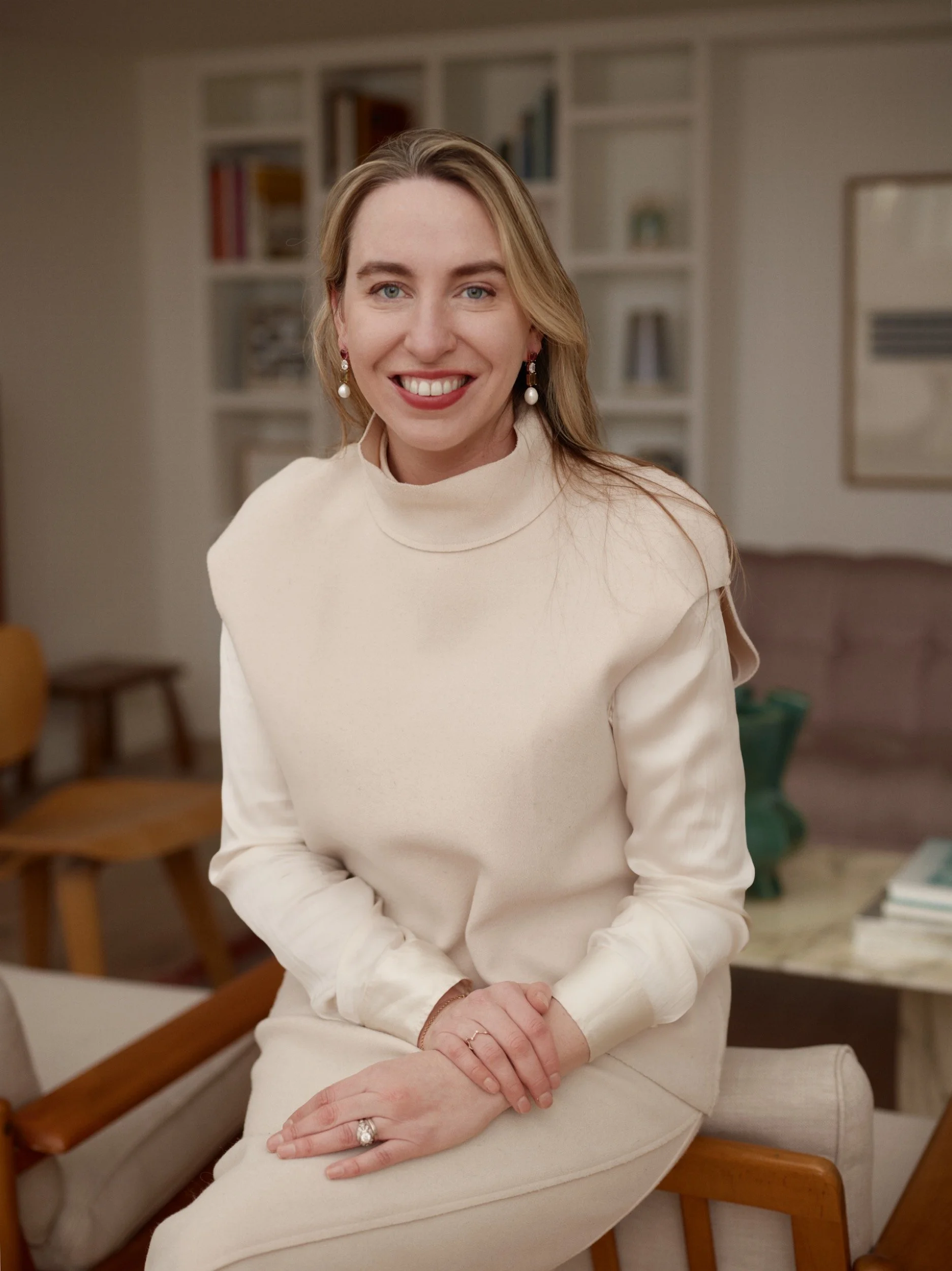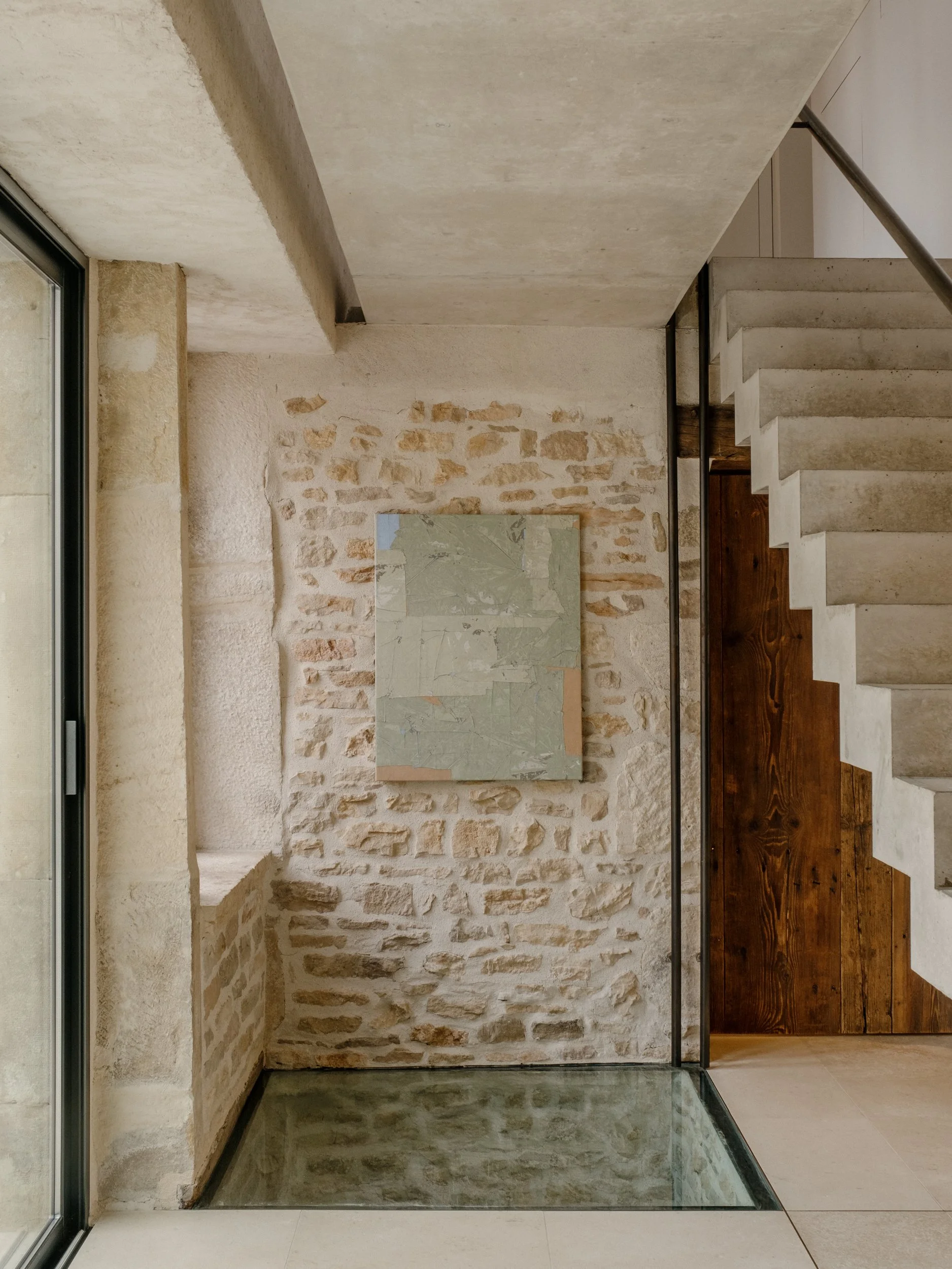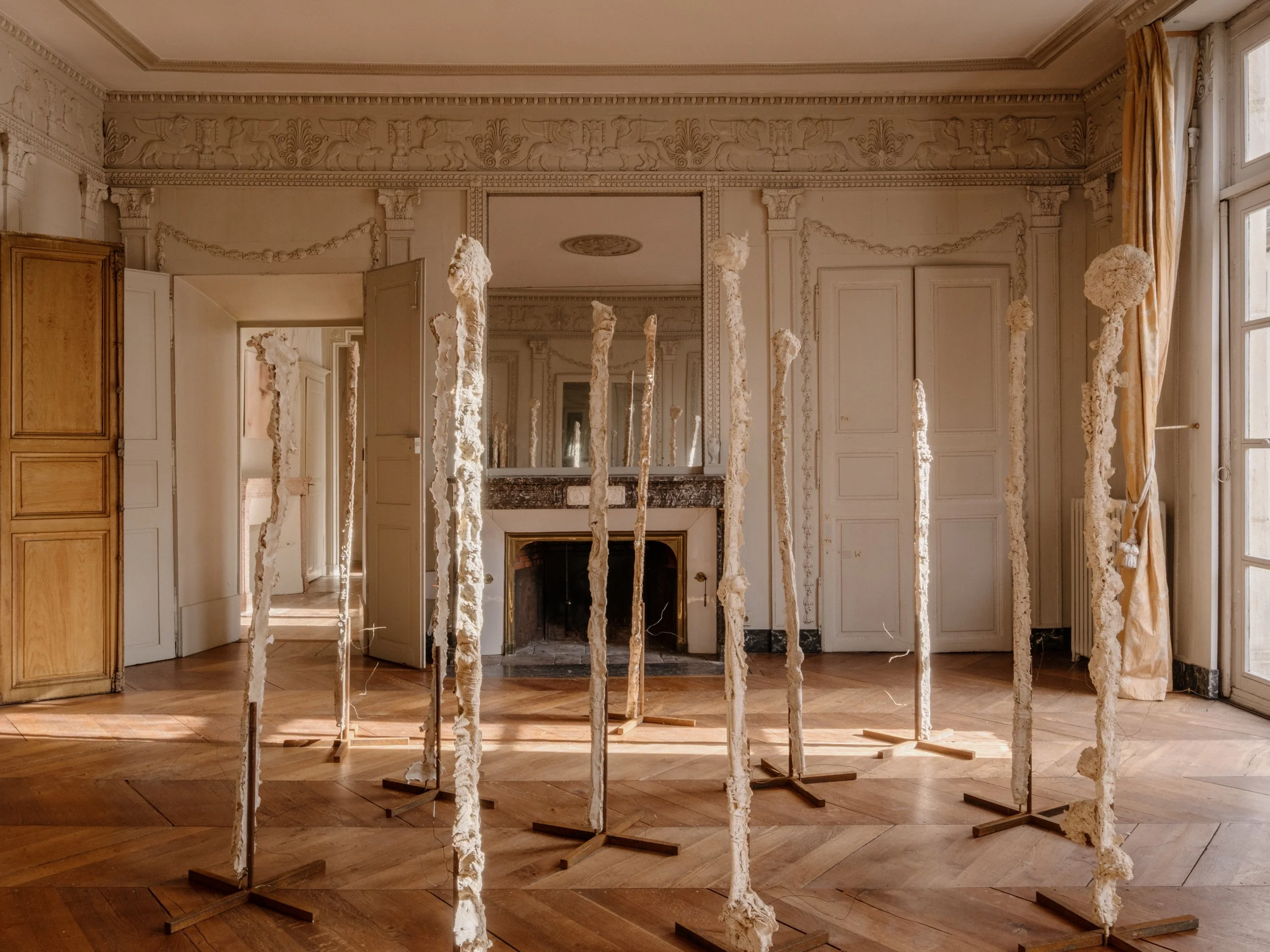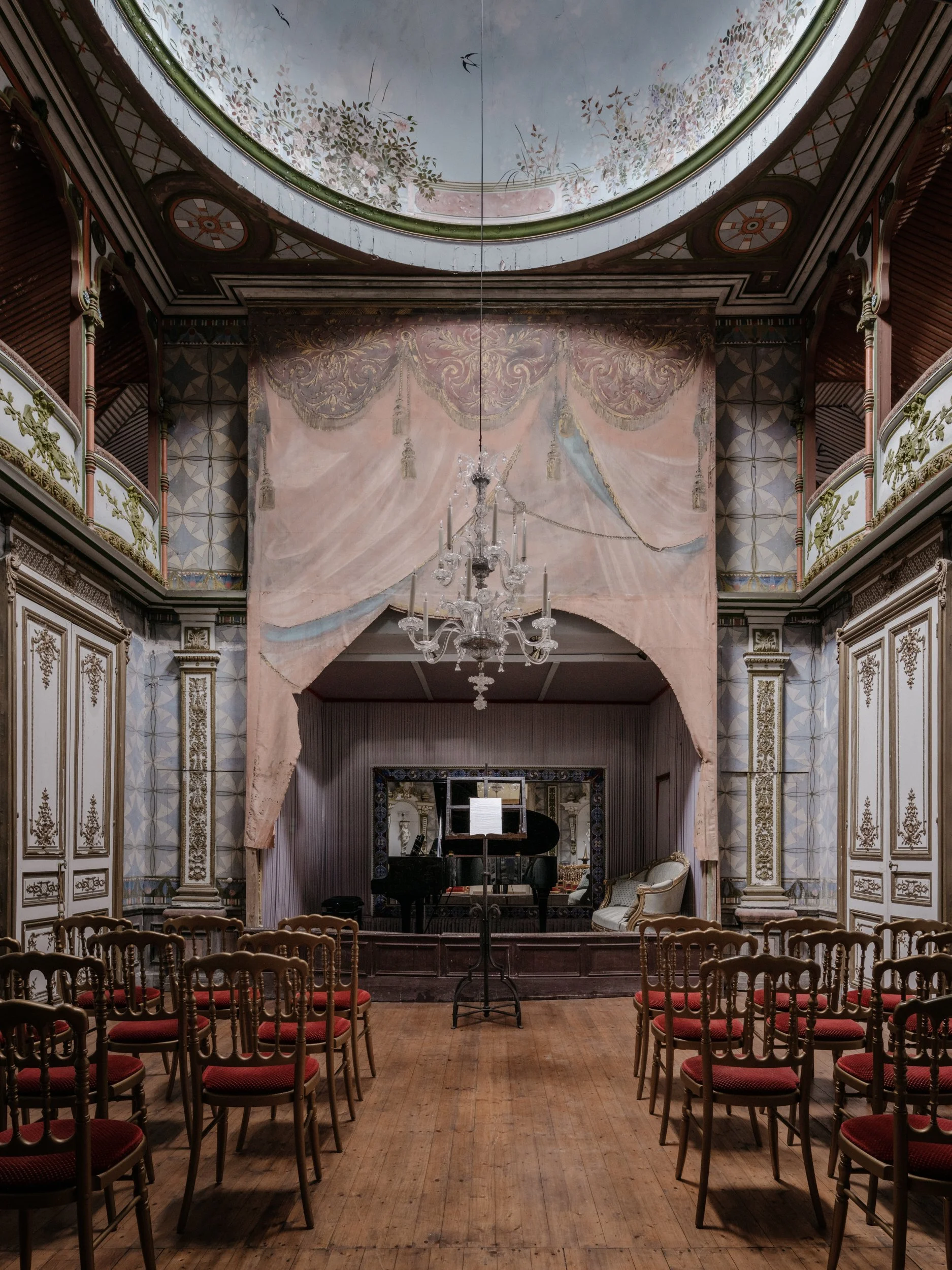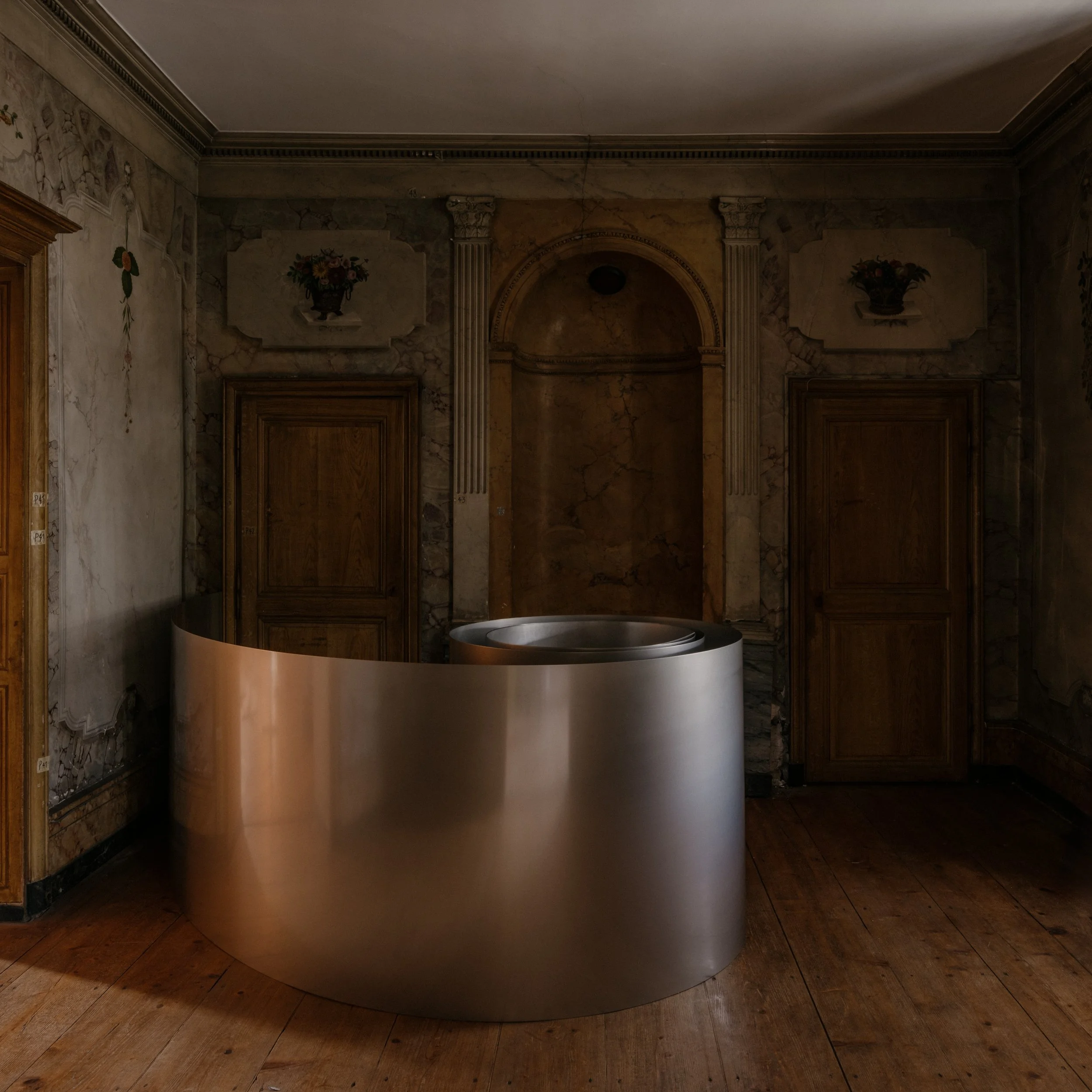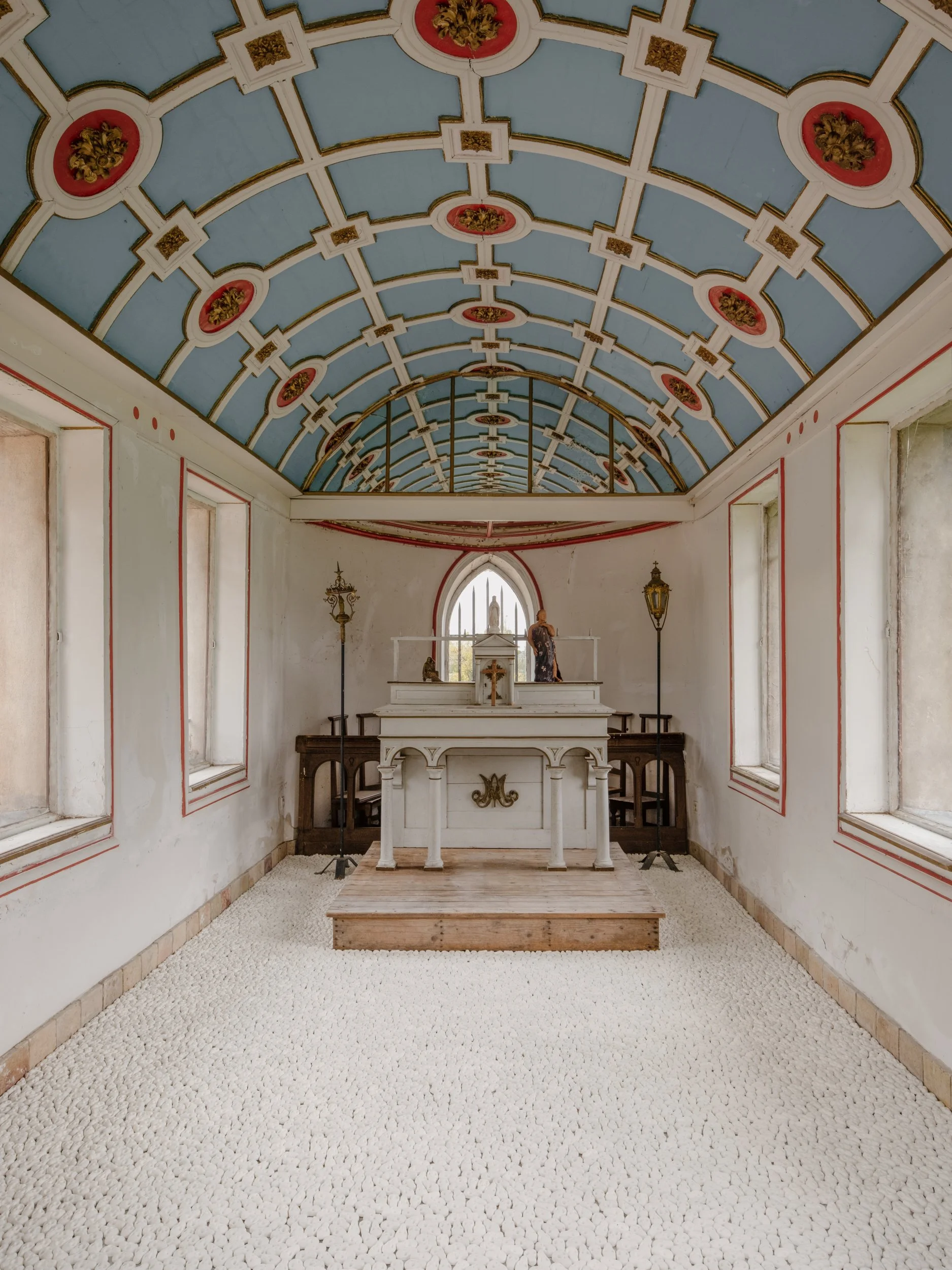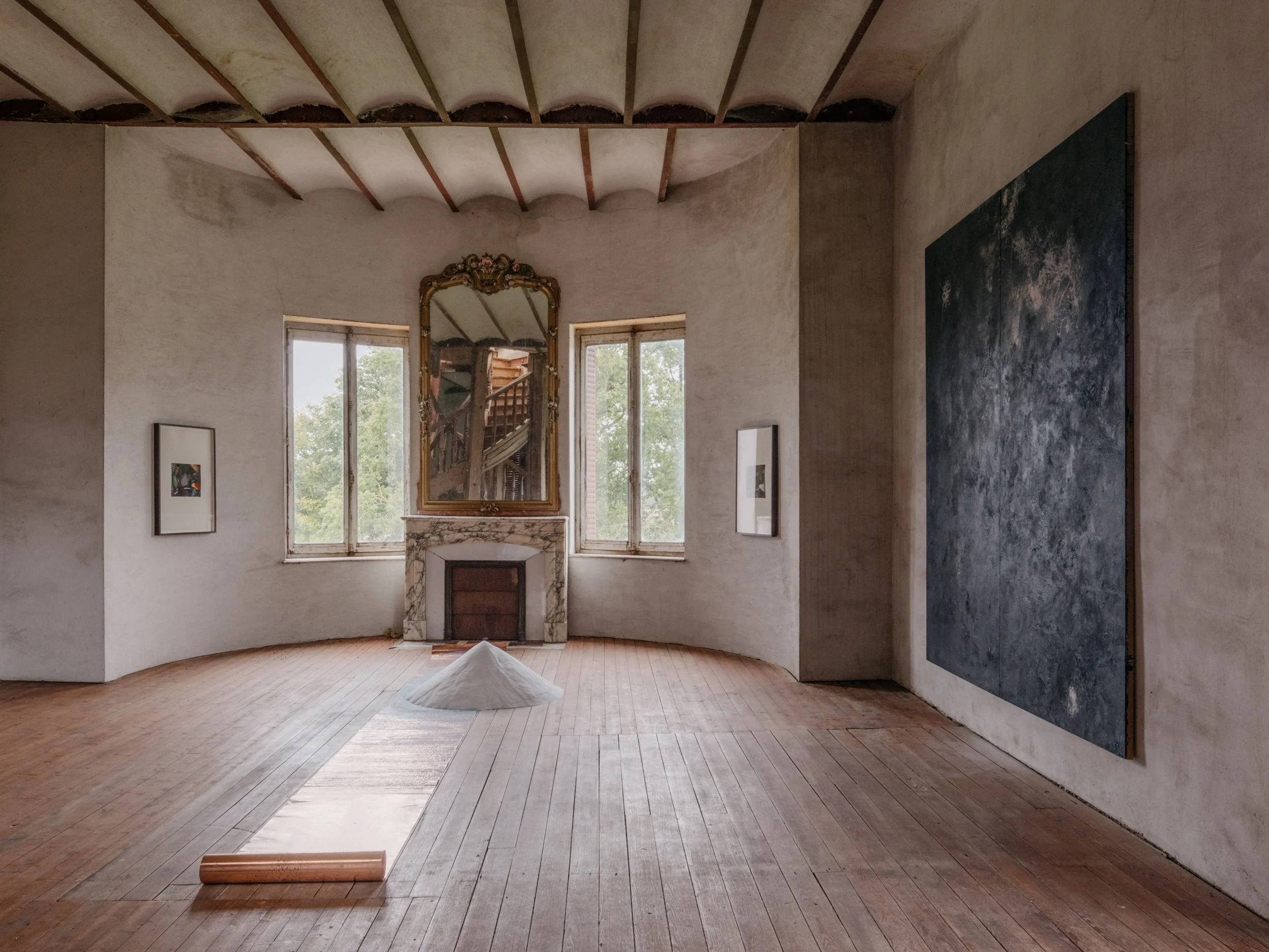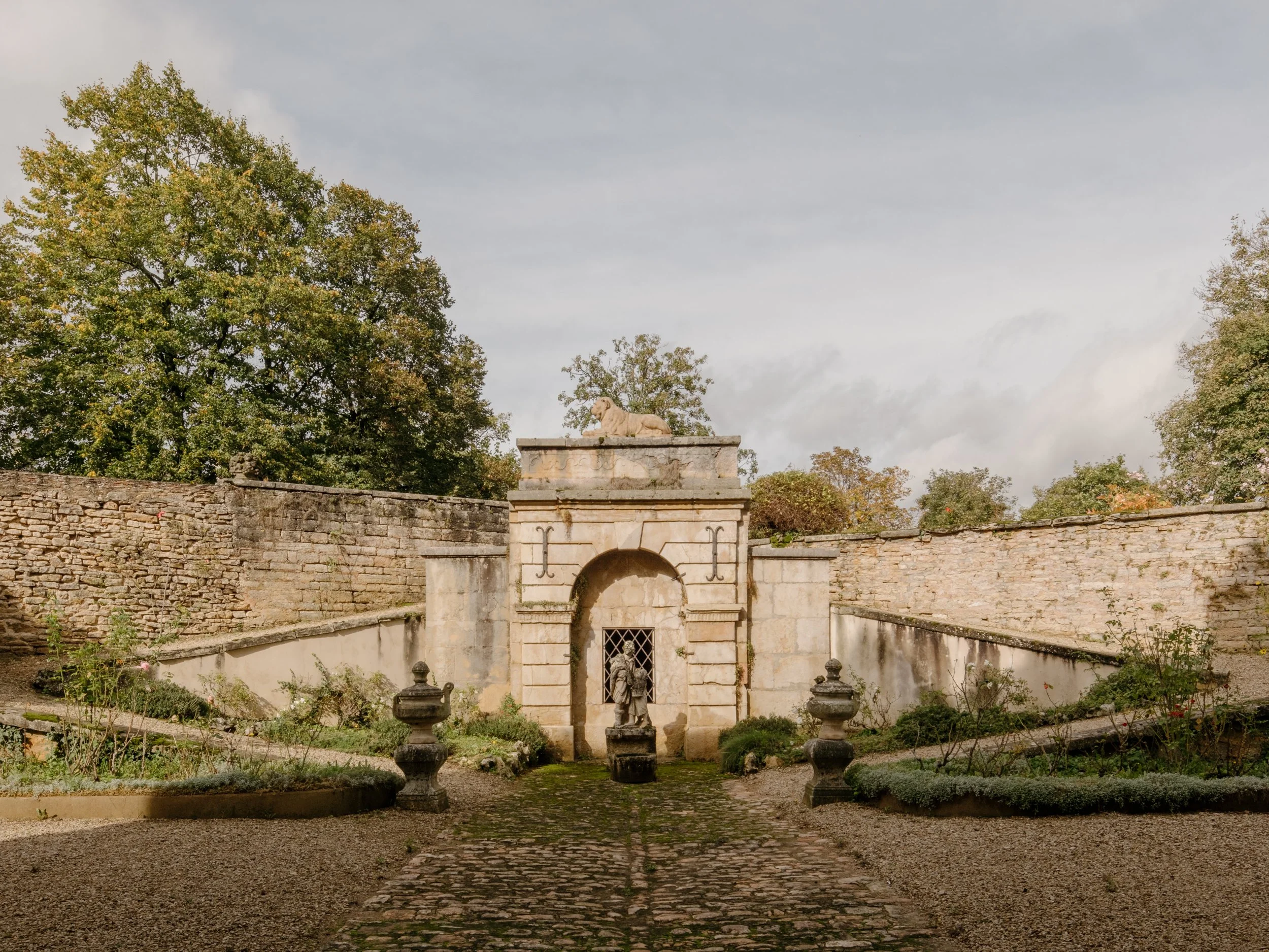From Concept to Creation: Curator Jenn Ellis Explores the Depths of ‘Terra’
Portait of Jenn Ellis. Photography by Bart Pajak
At Frieze London, I first encountered Jenn Ellis's work through an installation she curated for Breguet, the storied watchmaker known for its legacy of precision. She had chosen to highlight Milŋiyawuy (2022) by Indigenous Australian artist Naminapu Maymuru-White—a piece recently acquired by Tate Modern that explores First Nations cultural narratives and water motifs. Having first seen Maymuru-White's work at Stranieri Ovunque – Foreigners Everywhere, this year's Venice Biennale, I immediately connected to her piece. Meeting Ellis at Frieze, we bonded over our shared Colombian heritage on our mothers' side, sparking a broader conversation on cross-cultural influence and art's capacity to transcend boundaries. This exchange led me to her work on TERRA, a groundbreaking exhibition set amid Burgundy's vineyards.
La Maison de Pommard. Antoine Langenieux-Villard. Abrasée XLIV, 2024. Vinyl paint, collage and sewing on canvas. 90 x 70 cm. Courtesy TERRA.
In this lively and thoughtfully layered conversation, we delve into the inspirations and challenges behind TERRA. Ellis's artistic vision has brought this ambitious biennale-scale project to life with co-curator Emie Diamond. Tastefully produced alongside Milena Berman, TERRA is a groundbreaking exhibition situated amongst Burgundy's legendary vineyards, a UNESCO World Heritage site, in Beaune, France. Unlike any in the region's recent history, it's a project designed to bridge art and terroir—a concept that captures the ineffable interplay between soil, climate, topography, and tradition. In wine, terroir encodes a region's character into every bottle, transforming each sip into a sensory map of place and history. This spirit is embodied by over 40 international artists, whose works are woven into Burgundy's rich historical sites—from private châteaux to hôtel particuliers, spaces rarely accessible to the public. During a thoughtful meeting with Wolfgang Tillmans at Paris Art Basel in the Grand Palais, he shared his contentment in being part of the exhibition, underscoring the project's ambitious scale and Ellis's talent for drawing exceptional artists into this unique dialogue with place.
Résidence de Moyne-Blandin (67 Pall Mall). Jodie Carey. Guard, 2024. Jesmonite, earth, steel, wire. Variable (14 works). Courtesy TERRA.
Supported by Burgundy's local winemakers, TERRA invites audiences to experience a deeply contextualized intersection of contemporary art, regional history, and viticultural heritage. The exhibition is not just a static display but a sensory journey that unfolds in immersive contexts. Each location is uniquely curated to enhance its historical resonance, making you feel involved and connected. The Napoleonic-era Château de Chevigny en Valière and the neo-classical Résidence de Moyne-Blandin, owned by 67 Pall Mall, become immersive contexts for experiencing art through terroir, bringing the past to life in a way that is both engaging and memorable.
Château de Chevigny-en-Valière. Dahn Vo. 2.2.1861, 2009. Ink on paper. 24 x 3 x H.33 cm. Courtesy TERRA.
At the Château's ornate theatre, a piece by Danh Vo, Untitled (ongoing), consists of a transcribed farewell letter initially written in 1861 by French missionary Jean-Théophane Vénard, calmly awaiting his execution for proselytizing in Vietnam. Vo's father, Phung Vo, a skilled calligrapher, rewrites this letter in French—a language he neither speaks nor understands—upon his son's request. Vo's letter displayed on a music stand found in the site holds a restrained beauty, positioned thoughtfully in a space echoing both the intimacy and grandeur of the Italianate theatre, designed by Jean-Louis Charles Garnier, architect of Paris's famed opera house, the Palais Garnier. The interplay of historical gravitas in situ and personal connection creates a moving installation that resonates deeply within the architectural opulence of the theatre.
This curatorial sensitivity extends into other rooms, where installations resonate within their architectural settings. Meta Drčar's Spiral (2024), a metallic coil that unfurls upward, recalls the iconic gesture of Robert Smithson's Spiral Jetty (1970) yet asserts its presence within the space. The work engages with the room's corroded walls in a strikingly organic dialogue, merging with the architecture in a way that blurs the line between installation and environment—an integration that feels almost inevitable, as if artwork and space were always meant to exist as one. Its placement speaks to the temporal shifts and cycles inherent to site-specific intervention that feels both transient and enduring. Nearby, David Whitehead's ceramics, echoing utilitarian vessels, evoke the idea of artifacts left behind by the Château's predecessors. His work's rough, tactile quality offers a potent juxtaposition to the surroundings. At the same time, local artist Emmanuelle Rosso's expansive, ocean-drenched green-blue tapestry hangs adjacent, immersing viewers in its cascading hues and echoing Burgundy's rural past through fluid, elemental forms. These works, positioned in dialogue with one another, invite viewers to engage from diverse visual and conceptual vantage points, seamlessly merging with and recontextualizing the château's storied architecture.
Résidence de Moyne-Blandin (67 Pall Mall). Meta Drčar. Frame Series, Work No. 2 (III), 2024. Stainless steel. 100 x 1400 cm. Courtesy TERRA.
The exhibition is infused with diverse voices, from established artists to emerging talents, selected through an international open call. This process brings fresh perspectives to TERRA, with artists like Chechu Álava, Raffael Bader, Johanna Bath, and Matthias Bitzer adding unique narratives to the curatorial vision. The open call has notably broadened the exhibition's scope, drawing in artists of significant acclaim, including Niamh O'Malley, who represented Ireland at the Venice Biennale with her evocative pavilion Gather. Her presence enriches the dialogue within the show, infusing it with layered perspectives that resonate beyond geographical boundaries. O'Malley's sculptural installation, Untitled (2024), presents four parentheses crafted from stained and polished beech, framing an intimate, interstitial space that encourages quiet reflection.
Syagini Ratna Wulan, a young Indonesian artist, brings a futuristic and spiritual edge to the exhibition with her reflective acrylic and resin sculptures, evoking an otherworldly, sci-fi quality. Positioned near a winding tower staircase, her works resemble portals to another dimension, immersing viewers in a complex dialogue with the château's historical setting. Fellow Indonesian artist Mar Kristoff, recently recognized with a prestigious award in his home country, explores animism in his blurred black-and-white paintings, infusing the space with a haunting, ethereal presence. The contrast between Wulan's sleek, futuristic forms and Kristoff's spectral visions alongside the château's timeworn interiors creates a compelling interplay of past and future, offering visitors a sense of continuity and transformation woven into the architectural narrative.
Château de Chevigny-en-Valière. Nino Sarabutra. What will you leave behind?, 2021. Porcelain. Installation: 13 sqm (Total number of skulls: approx. 9,100). Courtesy TERRA.
Thai artist Nino Sarabutra's installation at the chapel of Château de Chevigny en Valière transforms the space into an immersive meditation on mortality and human connectedness. Thousands of ceramic skulls, laid across the floor in a meticulously arranged, puzzle-like formation, invite viewers to step directly onto the work, rendering each movement a tactile encounter with impermanence. The chapel's mirrored walls amplify this effect, creating an expansive, almost infinite vista that blurs the boundaries between art, architecture, and reflection. Shown originally at Bangkok's Wat Phra Pathom Chedi, Sarabutra's piece finds new resonance here, where the chapel's solemnity and mirrors cultivate a layered, haunting dialogue between presence and transcendence.
As an art experience, TERRA expands on the exhibition model by connecting it to the land and architecture. It redefines the art event in a rural setting by cultivating cultural dialogues rarely seen in Burgundy. Its finale will coincide with the 164th charity wine auction at Hospices de Beaune, hosted by Sotheby's, tying together TERRA's heritage, legacy, and artistry themes. Following its Burgundy run, the exhibition will continue to AORA, a virtual platform integrating art, architecture, and music, where Ellis aims to broaden TERRA's reach to global audiences. With this project, she has undoubtedly crafted a culturally resonant model for exhibitions, blending an appreciation for Burgundy's historical and agricultural richness with the dynamic voices of contemporary art.
La Maison de Pommard. Polina Piëch. Anew, 2022. C-type print on Fujiflex. 207 x 125 cm. Courtesy TERRA.
INTERVIEW
AMADOUR: Thank you so much for having me in Burgundy for the opening; it was incredible to experience it firsthand! TERRA is such an impressive project, and I'm in awe of its scale. This region's deep roots in winemaking history—and the strong support from the local community, especially the winemakers—add a truly authentic touch. Wine is so integral to the culture here in Beaune, and it's fascinating how something so connected to the land reflects in the exhibition itself. I'd love to start there—how does the local community shape the exhibition? How did those connections come to life?
JENN ELLIS: It all started when I met Milena Berman, the cultural producer behind Hautes Côtes, who has lived in Burgundy for over a decade. Her partner, Loïc Lamy, is a wine specialist, and together, they're closely connected to the local wine community—their child even goes to the local school. Over time, I noticed how thoughtfully Milena chose wines for each meal, and when I asked her about it, she opened up about the deep link between wine and Burgundy's cultural history. Our collaboration grew naturally from there. Milena began selecting wines for exhibition openings, blending the experiences of art and wine. As we talked more, she shared her vision of creating something big for the region—a way to bring contemporary art to a place that didn't have much of it. That's how TERRA was born. We saw it as a chance to transform Burgundy's heritage sites into immersive art spaces, creating something truly unique where it hadn't existed before. By February 2022, I was visiting Burgundy, seeing the potential in the quiet, old buildings around us and imagining how contemporary art could bring new life to the area and activate these spaces.
AMADOUR: That's such a beautiful, organic evolution. Seeing how deeply the community is embedded in the project is fascinating. Which specific winemakers have been involved in this edition of TERRA? This integration highlights the strong connection between the exhibition and the region's viticultural nuance.
JENN ELLIS: We've been fortunate to collaborate with several key players in the Burgundy wine world for this iteration of TERRA. We partnered with the Gagey family of Maison Louis Jadot, a name synonymous with Burgundy wine. Another major player is the Vanette family, who hosted us at an ancient theater site. Then there's Isabelle Ulti, whose family has been in the wine business for generations. Though Isabelle has moved away from winemaking and into hospitality, her family remains deeply rooted in the region's culture. Her property, MIS, serves as one of the exhibition's venues.
We've also been working closely with 67 Pall Mall, a prestigious wine club based in London with international reach, who've been partners for two years now. Additionally, the château you visited is owned by Stéphane Sésé, a newcomer to the Burgundy region who was originally from Champagne. He's involved in winemaking with his champagne brand, Boërl & Kroff, and has been a great supporter of TERRA.
Château de Chevigny-en-Valière. Haroun Hayward. Craigs Birch Winter, No. 6, 2022. Watercolour on paper. Framed: 83.7 x 64 x 4.5 cm; Haroun Hayward. Craigs Birch Winter, No. 11, 2022. Watercolour on paper. Framed: 83.7 x 64 x 4.5 cm; Mariana Hahn. Copper and Salt, 2019. Copper, salt. 1000 x 60 x 50 cm; Sebastian Lloyd Rees. Night Sky, 2021-2023. Oil and acrylic on wood. 250 x 250 cm. Courtesy TERRA.
AMADOUR: The interplay between the wine culture and the art feels very natural. Let's talk about your collaboration with Emie Diamond. How did that come about?
JENN ELLIS: Emie and I first met at an exhibition I curated in 2022 in a converted church in Marylebone. We were working with Singaporean artist Dawn Ng, and our PR team had invited Emie to the opening. We ended up sitting across from each other at lunch and clicked immediately. After the show, she reached out, and we began discussing the possibility of collaborating on future projects.
At the time, I was working on a proposal for a new exhibition at a former textile factory in East London, which had also served as Tracy Emin's studio. I asked Emmy if she wanted to co-curate, and by October 2022, we had co-curated our first show together. It worked so well that I knew I needed Emmy on board when TERRA came into being. The scope of TERRA is so large that I wanted to bring in multiple curatorial voices to enrich the project. So I asked her to join as co-curator, and she immediately said yes.
AMADOUR: You can feel the strength of that collaboration throughout TERRA. There's a harmony between the different curatorial voices, yet each part of the exhibition has its unique identity. Let's talk about some of the artists involved. Emmanuel Rosso's large-scale tapestry stood out to me. Can you share how that piece came together?
JENN ELLIS: Emmanuelle Rosso is a local artist based in Burgundy, and her work is deeply connected to place. Her tapestry, Rhizome (2024), reflects the organic, interconnected nature of her relationship with the land. She creates her works using natural pigments; in this piece, the sea and saltwater played a key role in its creation. There's something so elemental and tactile about her process—it's as if the work itself is infused with the spirit of the land.
The title, Rhizome, refers to these underground networks that connect different organisms. It's a beautiful metaphor for TERRA, where various artists, spaces, and histories are interwoven into a larger narrative. We displayed the tapestry in conversation with David Whitehead's ceramics, and the dialogue between the two materials—textiles and ceramics—was compelling. Both are tied to nature and craft, and their placement within the space was intentionally theatrical, almost like a stage set.
AMADOUR: The way the colors and textures interacted was so immersive. It felt like the room itself was part of the artwork. Another moment that stood out was the minimal spiral-shaped sculpture on the upper floor. It had such an impactful presence. How did you decide on that space for the installation?
JENN ELLIS: That piece is by Meta Drčar, one of the open-call finalists. Meta's work is always site-specific, and she's incredibly attuned to how her sculptures respond to the architecture and light of a space. We initially considered placing her work outside, but we couldn't alter the landscape due to the building's protected status as a heritage site. We found a perfect room indoors where we couldn't hang anything on the walls, and Meta's sculpture became the ideal intervention for the space.
Her spiral form feels like it's growing out of the floor, echoing the cyclical nature of the environment it's placed in. The piece embodies a sense of movement and transformation, which ties beautifully into the themes of liminality and transition that we explore throughout TERRA.
Château de Chevigny-en-Valière. Anna Blom. Lost in Responsibilities, 2023. Acrylic, raw pigment, situational debris on canvas. 190 x 150cm; Mia Chaplin. It Curdles, 2024. Oil on canvas. 160 x 200 cm. Courtesy TERRA.
AMADOUR: It reminded me of the minimalist works of Donald Judd. It was such a robust and quiet moment in the exhibition; the plaster sculptures in the next room were equally compelling. They seemed to interact with the light in such a delicate way. Can you tell me more about those pieces?
JENN ELLIS: Yes, those sculptures are by British artist Jodie Carey. They're made from plaster and mica and explore themes of memory, loss, and the passage of time. What's fascinating about her work is how it captures a sense of impermanence—the fragile nature of plaster combined with the elemental beauty of mica. As the sunlight shifts throughout the day, it casts different shadows and highlights across the surfaces, almost like the sculptures evolve with light.
Carey's work speaks to the idea of what we leave behind, and in the context of TERRA, it felt like a reflection on Burgundy's agricultural history. With its Egyptian-inspired decor, the room adds another layer to the dialogue, invoking ancient civilizations and their relationship with nature and craftsmanship.
AMADOUR: The conversation between the sculptures and the space felt so rich. Moving on to the Château de Chevigny en Valière, the entire building has a compelling history. One piece that stood out to me was Danh Vo's letter installation in the theater. Can you talk more about that?
JENN ELLIS: Danh Vo's installation is displayed at the center of this beautiful, ornate Italian-style theater designed by Jean-Louis Charles Garnier, best known for designing the Opéra Garnier in Paris. The space is so opulent that we knew the artwork needed to be simple yet powerful. Vo's letter installation felt like the perfect fit.
The work involves a letter written by a French missionary in 1861, just before his execution in Vietnam. Vo's father, who doesn't speak French, transcribed the letter in calligraphy, adding a deeply personal, almost imperfect layer to the work. The piece speaks to themes of language, colonial history, and intergenerational memory. The fact that it's placed on a music stand in the theater creates a sense of anticipation as if the letter is waiting to be performed.
AMADOUR: It was a thoughtful juxtaposition of stillness and motion, history and memory. I was also struck by Nino Sarabutra's work in the chapel—how viewers were invited to walk on porcelain skulls. Can you tell me more about that installation?
JENN ELLIS: Nino Sarabutra's installation, What We Leave Behind (2012 - ongoing), is profoundly meditative. Visitors are invited to take off their shoes and walk on a carpet of ceramic skulls arranged on the chapel floor. The skulls are beautiful and fragile, and walking on them becomes a physical, contemplative experience. It asks viewers to reflect on the fragility of life and what we leave behind when we're gone. With its religious significance, the chapel adds another layer of meaning to the piece. It becomes a space for quiet reflection on mortality, memory, and the legacies we create.
AMADOUR: It was such an immersive, almost spiritual experience. I also loved how the exhibition engages with the concept of terroir, reinterpreting it through art. Can you expand on the connection between terroir and TERRA?
JENN ELLIS: At the heart of TERRA is the concept of terroir, which in winemaking refers to the unique characteristics of a place—the soil, climate, and landscape—that influence the wine produced there. In the context of TERRA, we've reinterpreted terroir to explore the deep connection between art, place, and history. Each exhibition location is steeped in its unique history, and we wanted to create a dialogue between the contemporary art and the heritage of these spaces.
As visitors journey through the exhibition, they're invited to "taste place" in these distinct environments, engaging all their senses. It's not just about seeing the art—it's about experiencing the place, the history, and the atmosphere. We wanted to create an immersive exhibition deeply rooted in its surroundings.
Résidence de Moyne-Blandin (67 Pall Mall). Exterior Courtyard. Courtesy TERRA.
AMADOUR: That immersive quality comes through. Thank you so much for this conversation, Jenn. It's been fascinating to hear about the thought process behind TERRA. I can't wait to see you again in person soon!
JENN ELLIS: Thank you, Amadour! I'll be in LA soon for an exhibition I'm curating with Lucia Piani, a Venezuelan artist, for Frieze LA. Let's do a studio visit when I'm there.
AMADOUR: Absolutely! Let me know your schedule, and we'll make it happen.
JENN ELLIS: Will do. I'm looking forward to it! Thanks again for such a thoughtful conversation.
AMADOUR: Likewise. Take care, Jenn!
JENN ELLIS: You too, bye!
